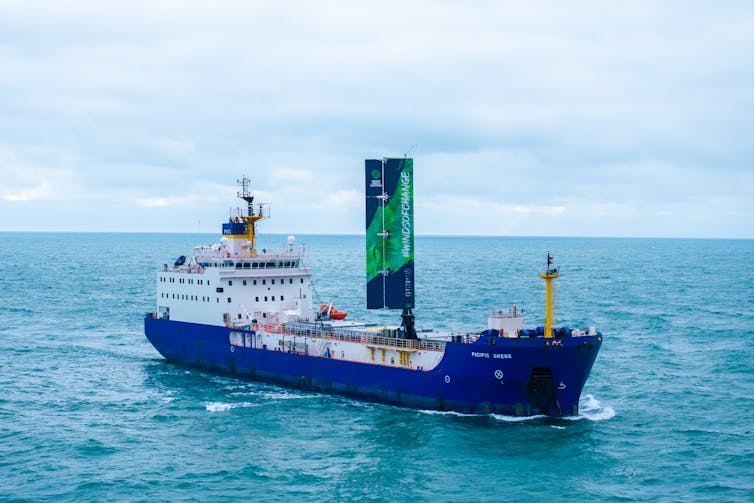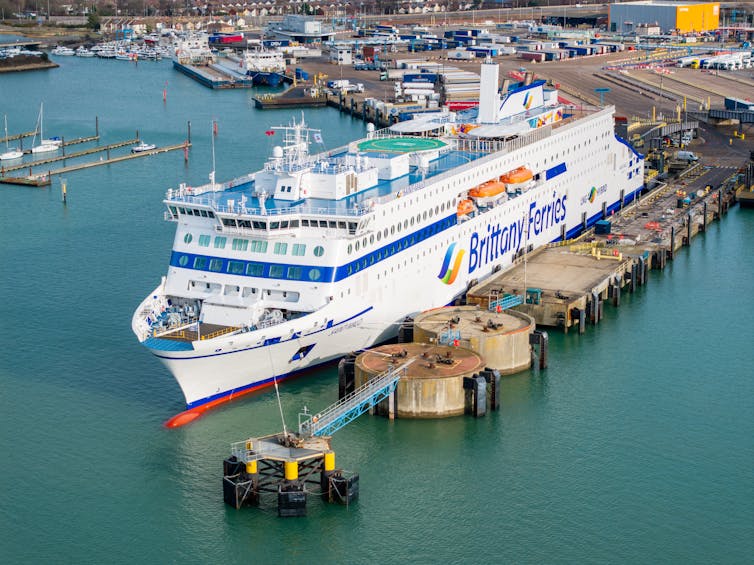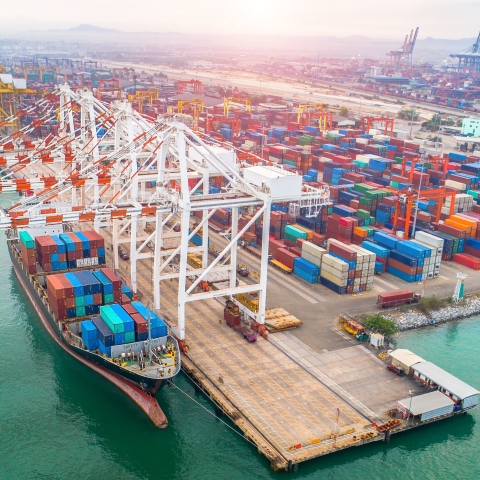

Dr Guy Collender, Post Doctoral Senior Research Associate at the Centre for Port Cities and Maritime Cultures, writes for The Conversation
Shipping generates 3% of global greenhouse gas emissions. This could increase to 10% if current trends continue, according to Transport & Environment – a non-profit organisation dedicated to decarbonising transport in Europe by 2050.
To alter course and reach the International Maritime Organization’s net zero target around 2050, shipping must adopt major changes and embrace large-scale innovations. Here are five ways the industry could respond.
1. Slow down at sea
The simplest, quickest way to minimise emissions is to reduce a ship’s speed. This practice is known as slow steaming. A much-cited 2011 report showed that a 10% reduction in speed means a 19% reduction in engine power for the longer journey. This means lower fuel consumption and lower emissions.
A 2021 study of slow steaming in the Mediterranean found that cutting a container ship’s speed by 13.6% led to 31% lower fuel oil consumption and carbon emissions. Such reductions can be even higher if the ship is powered by natural gas.
Slow steaming is an attractive option to reduce emissions as it doesn’t require new technology and infrastructure, but more time at sea affects the logistics and economics of international trade. Also, reductions in emissions will vary. One study shows that fuel savings (and, consequently, emissions) associated with reduced speed are at their best in calm weather.
2. Retrofit ships to use cleaner fuels
The largest container ships can consume up to 400 tonnes of fuel a day. Burning fossil fuels on such a scale is a major concern, so decarbonising the existing global shipping fleet is a priority. Without major progress on this front, up to 20,000 merchant ships could still depend on fossil fuels by 2050, according to Lloyd’s Register, the international shipping classification provider, which also provides energy transition advisory services.
Methanol – a flammable alcohol – is regarded as one of the green alternatives to fossil fuels. This chemical can be produced from renewable sources, including biomass or hydrogen. In 2015, the Stena Germanica cruise ferry became a trailblazer when its engines were converted to use methanol.
Last year, more than 100 methanol conversions were ordered. According to the engine retrofit report from Lloyd’s Register, methanol is leading the way in retrofit projects.
There is interest in following suit with the gas ammonia, which is similar to methanol in terms of its energy density. Ammonia is made from hydrogen and nitrogen, but it is highly toxic. As a result, ammonia engine conversions are more complicated than their methanol equivalents.
Of course, work on new build vessels powered by greener fuels is also desperately needed, but we cannot wait until large numbers of these vessels are ready. To minimise emissions, ships need to be retrofitted to use cleaner fuels and new ships using such alternative fuels should be built simultaneously.
3. Harness the wind, again
Ships have been powered by wind and sail throughout history. The arrival of the steam-powered vessel in the mid-19th century led to the decline of sail, but wind power could undergo a renaissance. According to DNV (a firm specialising in testing, certification and technical advisory services), vessel owners and operators have reported fuel savings of up to 9% for ships with wind-assisted propulsion systems.
The MV Pacific Grebe began sea tests with wing sails in October 2024 as part of the UK government-funded Winds of Change project, which involves academics from the University of Southampton.

Oceanbird a Swedish company, is developing futuristic wing sails to enable commercial ships to be partly, or largely, powered by wind. This most renewable of energy sources is not a perfect solution.
Prevailing weather conditions mean that certain routes are unsuitable for wing sails. As any sailor will tell you, wind can never be guaranteed. However, innovative approaches to harnessing this powerful force could reap dividends. Wind power could make a significant contribution to powering ships in future.
4. Expand shore power in ports
Ships not only produce emissions when at sea, but also when they are in port. This is especially true for cruise ships as they continue to run their power-hungry systems during port calls.
Such emissions not only contribute to climate change, but also to local air pollution, which harms human health. A recent global analysis shows how industrial port regions are a particular concern.
According to Transport & Environment, ships docking at Southampton released four times more nitrogen oxide than cars in the city. Between 2011 and 2050, most shipping emissions in ports are estimated to grow fourfold, according to Olaf Merk from the International Transport Forum.

To address these challenges to the environment and human health, ships in port could plug into electricity infrastructure on land instead of burning polluting fuel. Work is underway to bring shore power to three berths at Portsmouth international port as part of the £19.8 million Sea Change project involving partners including the University of Portsmouth and Brittany Ferries.
However, much more investment is needed globally. The International Chamber of Shipping says that only 3% of global ports offer shore power. Even where it is available, shore power is not always used because fuel oil is cheaper than electricity. Immediate and large-scale investment in shore power is needed, and the shipping industry must be persuaded to use these facilities for the good of the planet and local populations.
5. Update government plans
Technical solutions are essential, but they will not fulfil their potential without incentives and supportive policies. In the UK, the Labour government must urgently update the clean maritime plan published by the Tories in 2019. That plan was due to be reviewed and updated in 2022, but a new version has yet to be issued.
Last July, the UK Chamber of Shipping and seven other maritime trade bodies called on Mike Kane MP (Minister for Aviation, Maritime and Security) to make this “an early and top priority”. Reaching net zero will require collaboration from the private sector and the UK government, as well as other governments worldwide. The UK government can contribute to this global challenge by producing a new clean maritime plan to explain its plans for UK shipping to reach net zero.
![]() Guy Collender, Post Doctoral Senior Research Associate, Centre for Port Cities and Maritime Cultures, University of Portsmouth
Guy Collender, Post Doctoral Senior Research Associate, Centre for Port Cities and Maritime Cultures, University of Portsmouth
This article is republished from The Conversation under a Creative Commons license. Read the original article.
You might also like...
Car tyres shed a quarter of all microplastics in the environment – urgent action is needed
Every year, billions of vehicles worldwide shed an estimated 6 million tonnes of tyre fragments. These tiny flakes of plastic, generated by the wear and tear of normal driving, eventually accumulate in the soil, in rivers and lakes, and even in our food. Researchers in South China recently found tyre-derived chemicals in most human urine samples.
Alex Ford
27 November 2024
6 min read

Podcast focuses on shipping and energy transitions: from sail to steam and to the green technologies of the future
Guy Collender
26 November 2024
15 min listen

Call for Papers: Port Cities and Maritime Cultures International Conference, 10-11 June 2025
The Centre for Port Cities and Maritime Cultures is holding its inaugural conference (10-11 June 2025) at the University of Portsmouth.
Guy Collender
24 October 2024
2 min

